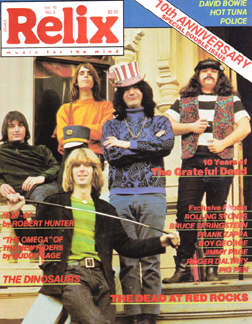Dead Relics: Brian’s Pick (9/19/70- Fillmore East)
Starting today, we’ll set you off on each weekend with a suggestion from the expansive Grateful Dead catalog, along with some streaming audio you can enjoy.

To kick things off, Video Manager Brian Stollery recommends September 19, 1970 at the Fillmore East, with a particular focus on the “Dark Star.”
Here’s is what Brian has to say…
September 1970 found the Grateful Dead sandwiched squarely between the release of their two most celebrated albums, Workingman’s Dead and American Beauty. The untamed, LSD-drenched 1967 sound had been fused with an indelible roots and country-tinged songwriting sensibility and a clearer, more sustained voice, reflecting, in part, Robert Hunter’s newfound appreciation for The Band. If San Francisco offered the Dead a comfortable home setting in which to explore, then New York City presented a proving ground. The sharp, raw, energy of the city demands the best of its visiting performers, and this energy often lit up the Dead in electric dayglo hues, eliciting some of their strongest, darkest, and most hauntingly psychedelic performances. One such performance occurred during the late hours of Saturday, September 19th, at Bill Graham’s famed Fillmore East venue on 6th street in Manhattan.
Early Dead member Tom Constanten has said, “’Dark Star’ is going all the time. It’s going right now. You don’t begin it so much as you enter it. You don’t end it so much as leave it. Any Fillmore East ‘Dark Star,’ I would recommend.”
At its strangest, this particular “Dark Star” presents an amorphous, industrial soundscape that conjures images of ancient ships peering through dense fog of the dusk, an ape slowly raising his head to ponder the great monolith, the vastness of space, the infinite cycle of life, the primordial ooze. Sharp, minimal jabs of percussive distortion are reminiscent of avante-garde proto-electronica, such as Phil Lesh’s experiments with Ned Lagen or early, experimental Kraftwerk albums. It’s very weird, and very dark.
Then at the 16-minute mark, the one-thousand-leafed lotus flower unfolds and blooms in perfect synchronicity with the rising sun and the promise of a new day. Like fresh rainfall in a barren reservoir, the darkness gives way to light as the band launches all together into a blissful, major, descending riff that patiently coalesces into the main riff. The second and final verse follows, and then, to the audible delight of the animated crowd, “St. Stephen!”
What follows is a relatively short sequence of “Not Fade Away” > “Turn On Your Lovelight.” Around the 5-minute mark, “NFA” veers yet again into the realm of mystery as the jam takes on a dark, exploratory life. This “Darkness Jam” (the only ever) leads into the only “China Cat Jam” to appear independent of the rest of the song. A 25-minute “Lovelight” complete with some fine Pigpen grunting and Bobby howling serves to re-assimilate the audience’s molecules (albeit in a slightly dyslexic order) and caps this exceptional fall ’70 show. As the Dead wrapped up around dawn, I imagine the venue personnel did their best to assist the troves of dazed hippies in finding their way back home from New York’s East Village, that moment of time preserved forever in the pristine glory of consciousness.
Here is the sequence that streams above
2) St. Stephen > (06:17)
3) NFA > (04:52)
4) Darkness Jam > (01:20)
5) China Cat Jam >(01:24)
6) NFA > (01:48)
7) Lovelight(20:45)



















